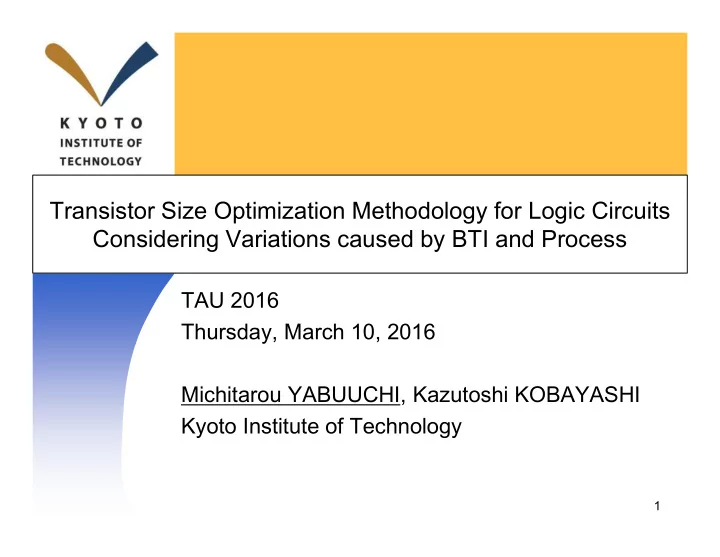

Transistor Size Optimization Methodology for Logic Circuits Considering Variations caused by BTI and Process TAU 2016 Thursday, March 10, 2016 Michitarou YABUUCHI, Kazutoshi KOBAYASHI Kyoto Institute of Technology 1
Kobayashi Lab. Summary Transistor Size Optimization Technique � BTI (Bias Temperature Instability) and process variations into consideration � Lifetime delay of logic path – 4.4% reduced � Area – no overhead � # of cells in library – 3x~ 2
Kobayashi Lab. Background – Aging Degradation + + A Y B Timing Delay Margin = Spec. Time ��������� �������������������������� ����������������������������� ������������� 3
� Kobayashi Lab. Transistor Size Optimization 9.3 Lp = Ln = 45 nm Delay RMS [ps] 9.2 Wp + Wn = 700 nm Wp 9.1 Wn 9.0 8.9 240/460 210/490 270/430 � ��� + � ��� Wn/Wp [nm] � ��� = 2 � Conventional – initial delay based 4
Kobayashi Lab. Impact of BTI on Inverter Slower to � dr increases by NBTI VDD turn ON (PMOS degradation) Input =1 Low High initial High Low aged Input = 0 � df increase by PBTI VSS Slower to (NMOS degradation) turn ON � Since 45 nm process – Both BTI � Imbalance – � dr and � df degradation 5
Kobayashi Lab. Purpose of This Study Margin reduced Delay Efficient guardband Time � Propose – lifetime delay based � Key ideas – Consider “lifetime experience” in logic gate design – Optimize transistor size to reduce “BTIGinduced variation” � Design cells for DF (Duty Factor) = 0, 0.5, 1 6
� Kobayashi Lab. Sizing – BTIGInduced Variation Standard Normal Quantile � =10 8 s � ��� : cnst. �� =0.5 � =45 nm ⁄ � ��� ∝ 1 �� Vth shift [mV] � Enlarge transistor size – reduce BTI variation 7
Kobayashi Lab. Results of Size Optimization 11 DF=0.5 DF=0 Delay RMS [ps] Prop. 10 Larger PMOS DF=1 Larger NMOS 9 Conv. Initial 240/460 270/430 210/490 Wn/Wp [nm] Lp = Ln = 45 nm Wp + Wn = 700 nm 8
Kobayashi Lab. Simulation Result – INV Chain 4.4% Conventional (initial based) Initial: 64.8 ps Lifetime: 76.6 ps Proposed (lifetime based) Initial: 66.5 ps Lifetime: 73.2 ps initial Lifetime (1) Lifetime (0) � Lifetime delay – improved w/o area overhead 9
Kobayashi Lab. Conclusion � Transistor size optimization technique – Conventional – initial delay based – Lead to large timing margin – Proposed – lifetime delay based – Path delay of inverter chain – improved by 4.4% – No requirement of area overhead – Support dependable and efficient chip designs 10
Thank you for listening!
Kobayashi Lab. BTI (Bias Temperature Instability) Recoverable Component �� ∆� Permanent Component Time 0 Stress Relaxation NBTI (Negative BTI) on PMOS PBTI (Positive BTI) on NMOS � �� < 0 � �� > 0 65 nm~ 40 nm HKMG~ 12
Kobayashi Lab. Technique to Overcome Degradation Adaptive NonGadaptive Techniques Techniques Body biasing Sizing Adaptive Strengthen Supply Voltage � Overhead required � Based on aging prediction 13
Kobayashi Lab. Physics – Atomistic TrapGBased Model ATGB Model Gate Gate Dielectric Drain Source : Defect (capture) : Defect (emission) � Defect – capture and emit carriers 14
Kobayashi Lab. Calculate �� Distribution by BTI DefectGcentric distribution Input: transistor size, stress condition Product of Nt and η Nt: number of defect (Poisson dist.) η: impact of single defect (Exp. Dist.) Output: ∆� �� P. Weckx et al � , IRPS 2014 15
� Kobayashi Lab. Physics – Scaling of BTI Defect in gate dielectric Scaling Number of defect – decrease Impact of single defect – increase � Average � ��� – constant ⁄ � Deviation � ��� – area dependent ( ∝ 1 �� ) 16
Kobayashi Lab. AgingGaware Library Logic Simulation Tr. Size Optimization Signal Probability Profile AgingGaware Library Cells Gate Mapping 17
Kobayashi Lab. Optimization for MultiGinput Gate A=1 A=0 A=0 A=1 B=1 B=0 B=1 B=0 15 A=0, B=0 Delay RMS [ps] A=1, B=0 14 A=1, B=1 13 A=0, B=1 initial 12 320/380 290/410 260/440 Wn/Wp [nm] 18
Recommend
More recommend